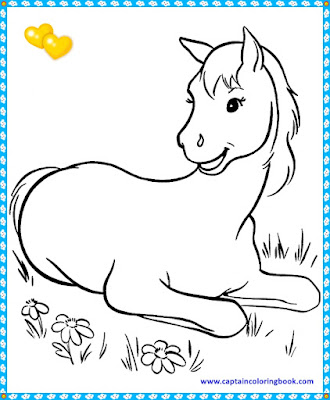 |
| Horse Coloring Book For Kids |
 |
| Horse Coloring Book For Kids-2 |
 |
| Horse Coloring Book For Kids-3 |
 |
| Horse Coloring Book For Kids-4 |
 |
| Horse Coloring Book For Kids-5 |
 |
| Horse Coloring Book For Kids-6 |
 |
| Horse Coloring Book For Kids-7 |
 |
| Horse Coloring Book For Kids-8 |
Horse Characteristics – Information About Horses
Characteristics of Horses
The adult male horse is called "stallion", the female "mare", young horses "foal", the one whose eggs are taken and castrated as "eel", the stallion used for breeding is called "breeder", the male of the harness horses is called "horse", and the female is called "göl" in some regions.
In the past, stallions were used for riding, while mares were kept for breeding purposes only. Gypsies were used in business life (forestry, agriculture, transport) and for women to ride horses. However, today the eels have replaced the stallions as riding horses.
Horses are divided into two main groups as warm-blooded horses (mountain horses), warm-blooded horses and cold-blooded horses (harness horses) according to their body structure, ability to run quickly and long, and load carrying capacity.
Warm-blooded horses are small, lively and delicate. The body is of medium size, light and slender. Muscles are underdeveloped compared to cold-blooded ones. The hairs covering the body are short. They can run very fast and continuously. It is generally used in passenger, light shooting, harness, transport and sports works. Its ability to adapt to the climate is good. Although it is very common in the world, the most well-known are the Arabian horses and the English horses, which are taller than him.
Cold-blooded horses are larger, heavily built, thick and rough-looking, their muscles are very developed and strong. The hairs covering the body are long, the head is large, the neck is short and thick, the rump is developed and strong. Their ability to adapt to the climate is low. Their movement is quite heavy, they easily pull plows and carts (Arden, Nonyus and Belgian horses).
Lifespan and Life Stages
Modern horses have an average lifespan of 25 to 30 years, depending on the breeding, care and environment. Rarely, however, have some horses turned their 40s, as if by defiance of time. The longest known horse in the 19th century was the "Oldbilly", who lived to be 62 years old. Sugar Puff, listed in the Guinness World Records as the oldest living pony in the world, died in 2007 at the age of 56.
Calculation of the ages of horses and ponies is based on January 1 in the Southern Hemisphere and July 1 or August in the Southern Hemisphere for racing purposes. For example, most Northern Hemisphere racing authorities consider January 1 to be the date when the official age of horses increases.
There are some terms used to describe the age of horses:
Colt: A foal of either sex less than one year old. Most foals are weaned at five to seven months of age, but foals can be weaned at four months without outside influence.
Young Horse: A horse of either sex that is one or two years old.
Stallion: A non-castrated male horse four years and older. The term "horse" is also sometimes used to mean stallion.
Mare: A female horse that is four years old or older.
Iğdiş: A castrated male horse of all ages.
Height and Weight
The horse's height is measured from the highest point of the horse, which is expressed as the "withdrawal" or "knuckle". This point is used because it is a fixed point in the anatomy, unlike the head or neck, which moves up and down relative to the horse's body.
The size of horses varies by breed, but is also affected by nutrition.
Light riding horses usually range from 142 to 163 cm and can weigh 380 to 550 kilograms.
Larger riding horses are usually around 157 cm to 173 cm long and usually weigh 500 to 600 kilograms.
Heavy horses can usually be at least 163 cm to 183 cm high. They can weigh around 700 to 1,000 kilograms.
Pony
There is only one difference between a pony and a horse. He is also tall. Small horses under 1.48 cm when measured from the withers are called ponies. But there are exceptions to this situation. In some places, a horse longer than 1.48 cm may be classified as a pony.
Due to their short stature, they are used as riding and pack animals for children who start riding and in some places. Robust, hardy and docile animals. Ponies are named according to the country in which they are bred: Scottish Pony, Shetland Pony, Corsican Ponisa, Togo Pony… In Turkey, ponies are mostly bred in the North Aegean region.



0 yorum :
Post a Comment